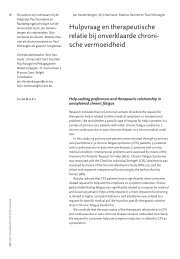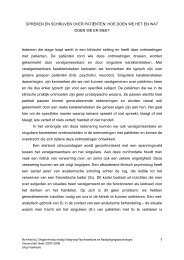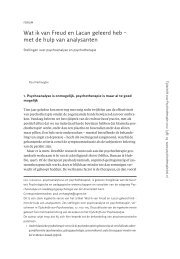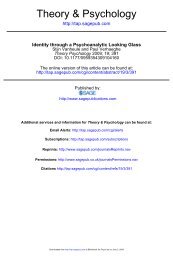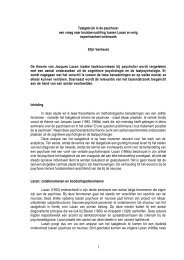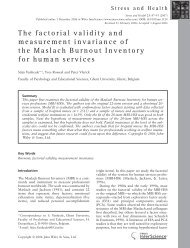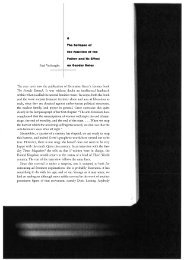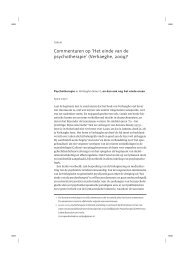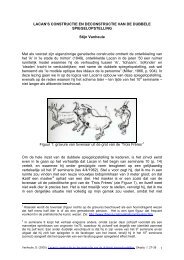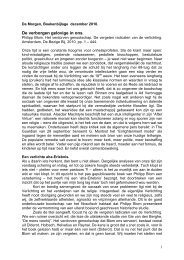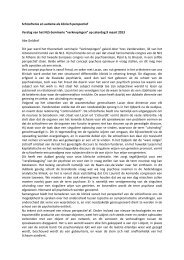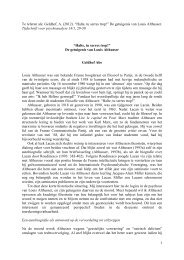Causation and Destitution of a Pre-ontological Non-entity
Causation and Destitution of a Pre-ontological Non-entity
Causation and Destitution of a Pre-ontological Non-entity
You also want an ePaper? Increase the reach of your titles
YUMPU automatically turns print PDFs into web optimized ePapers that Google loves.
formulating the link between the original, pregenital loss <strong>and</strong> the oedipalelaboration there<strong>of</strong>. For several reasons, the Freudian castration theory itself willnever be fully satisfying. Freud's focus on the real, that is to say the biologicalbasis <strong>of</strong> castration, did not help him any further either, <strong>and</strong> inevitably brought himto the pessimistic conclusion <strong>of</strong> 1937, concerning the 'biological bedrock' as thelimit <strong>of</strong> psychoanalysis. 12 Freud's theory is quite unidimensional <strong>and</strong> Freudhimself remained remarkably obstinate in this respect. He refused to take otherlosses than the loss <strong>of</strong> a penis into account – with one exception, as becomesclear from his affirmation <strong>of</strong> Aristophanes' fable about the search for the originallylost counterpart. 13This one-sidedness was directed by his conviction regarding the universality<strong>of</strong> the pleasure principle, i.e. <strong>of</strong> the desire to restore the original homeostasis.Things became more complicated once he discovered that there is a 'beyond' tothe pleasure principle, in which yet another kind <strong>of</strong> drive is at work, also strivingto restore an original condition, albeit a totally different one. 14 The duality <strong>of</strong> lifeversus death drives opened up a dimension beyond the one-sidedness <strong>of</strong> neurosis,castration <strong>and</strong> desire.It is this dimension that is taken into account by Lacan. Indeed, Lacan'sstarting-point is also the very idea <strong>of</strong> lack <strong>and</strong> loss, but he will recognize a doubleloss <strong>and</strong> a double lack. Moreover, the interaction between those two losses willdetermine the constitution <strong>of</strong> the subject. The duality also corresponds to thedouble level <strong>of</strong> desire <strong>and</strong> jouissance <strong>and</strong> it will find its most elaborateformulation within Lacan's discourse theory, in which it will be expressed bymeans <strong>of</strong> the two disjunctions (impossibility <strong>and</strong> impotence) governing eachdiscourse. 15In Seminar XI, Lacan began his discussion <strong>of</strong> the causation <strong>of</strong> the subject withsomething that was already well-known to his audience: the drive, being alwaysa partial drive, revolves around a lack. However, at that point, Lacan surprisedhis audience by stating that there are two lacks. 16 The first one is the lack in thechain <strong>of</strong> signifiers, the interval between two signifiers. This is the typicallyhysterical – <strong>and</strong> thus Freudian – level in which desire can never be fullyexpressed, let alone satisfied. In Lacanian terms, this reads that the subject, confrontedwith the enigma <strong>of</strong> the desire <strong>of</strong> the Other, tries to verbalise this desire<strong>and</strong> thus constitutes itself by identifying with the signifiers in the field <strong>of</strong> the Other,without ever succeeding in filling the gap between subject <strong>and</strong> Other. Hence, thecontinuous movement from signifier to signifier, in which the subject alternatelyappears <strong>and</strong> disappears. The ensuing alienation is a continuous flywheelmovement around the lack in the chain <strong>of</strong> signifiers, resulting in what Lacan4



